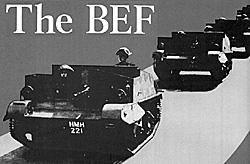 The BEF in 1940 was one of the best equipped and best trained forces ever sent into modern warfare. The troops were mostly long-term regulars and the officers were career professionals. Unfortunately, the BEF was equipped with the wrong weapons and trained in the wrong doctrines; and the BEF's most brilliant and best known achievement was a retreat.
The BEF in 1940 was one of the best equipped and best trained forces ever sent into modern warfare. The troops were mostly long-term regulars and the officers were career professionals. Unfortunately, the BEF was equipped with the wrong weapons and trained in the wrong doctrines; and the BEF's most brilliant and best known achievement was a retreat.
The campaign of 1940 didn't have to turn out that way. Although the rather stodgy character of the British Army was wel1 established by the mid-30's, the British soldier adapted rapidly to modern war after 1940. By then, of course, it was a bit late.
C. Northcote Parkinson describes the British training for WW II in The Law and the Profits as follows:
- "The government tendency is to prepare for the last war but one. Thus, the years immediately preceding WW II were devoted by the British Army to a training which would undoubtedly have won us the Boer War had that conflict been in the future rather than in the past. Troops were cunningly clad in a uniform that blended imperceptibly with the veldt or indeed with the Khyber Pass . . .
"On training exercises, the officers were mounted and the vehicles largely horse-drawn. When the enemy was encountered, his fire realistically indicated by waving flags, the accepted practice was for the commanding officer to canter on his white charger to the summit of some convenient hill, followed by his adjutant and intelligence officer. Lowering his binoculars, he would say 'Theah's the enemy!' The CO would presently be joined on the skyline by company commanders, also on horseback and waving their maps . . . "
Nor was the problem a lack of money. As Parkinson notes, the British "had voted the money, but that was nearly all they had done. Funds had been frittered away on correspondence and printing, upon clerks and ink. The British system of accounting was in itself worth an army corps to the other side; as indeed it still is."
Parkinson estimates German military expenditures in 1938 at about 1,333 million pounds, compared with the known British expenditure of 391 million pounds. The British Army consisted of 4 field divisions, with another five devoted to Anti-Aircraft and 13 Territorial divisions which "were later officially made to number 26. On the most optimistic reckoning, this would imply a total of 22 divisions, mostly ill-trained and all ill equipped, but more or less present and numbered off. By a comparison in relative expense the Germans, spending over three times as much, should have put, say, 75 divisions in the field. Instead they were able to mobilize 105 divisions, six of them armored and four of them motorized." (1938 establishment)
 At right: British infantry squad covers a small bridge where a Bren carrier moves forward during a divisional exercise in France. Thc trench parapet is indicated by pegged tape in front of the infantrymen.
At right: British infantry squad covers a small bridge where a Bren carrier moves forward during a divisional exercise in France. Thc trench parapet is indicated by pegged tape in front of the infantrymen.
It Might Have Been Different
It might have been very different. The character of the BEF was greatly influenced by the political skills of a single man. Leslie Hore-Belisha became His Majesty's Secretary of State for War in the newly reorganized Chamberlain Cabinet of May 28, 1937. A Jew of great administrative ability, Hore-Belisha had been amazingly effective in the reform of the Transport Ministry, and was sent to the War Office with instructions to make "drastic changes" Chamberlain told him that "the obstinacy of some of the Army heads in sticking to obsolete methods is incredible."
Not entirely by coincidence, on May 31, 1937, Capt. (ret.) Basil Henry Liddell Hart, then Military Correspondent for the London Times, was asked by Sir Thomas Inskip, Minister for Co-ordination of Defense, to prepare a paper on the subject of "how the Army might be reorganized to fit its functions better under modem conditions, and how a more powerful type of force might be created within the limits of the Army's existing size."
It may seem odd that a Government official might ask a private citizen for enlightenment on such an important subject; but Liddell Hart was known by the few students of war who took Blitzkrieg seriously to have created the doctrines of armored warfare. The Germans took him very seriously indeed: they modeled their Panzer divisions on the writings and ideas of Liddell Hart and Maj. Gen. (Ret.) J. F. C. Fuller, who between them may be said to have created the intellectual tools with which armored warfare would be fought.
Within a week of taking office Hore-Belisha was given the first parts of Liddell Hart's analytical paper on Army reorganization. A partnership was formed: Liddell Hart would furnish informal advice, and Hore-Belisha would carry out the organization.
Liddell Hart's advice extended far beyond tables of organization and equipment, or even fighting doctnnes. He also designated officers for promotion to the highest ranks in the Army, noted how the Territorial Army could be made more effective at lower cost, analyzed the Anti- Aircraft defense of both Bntain and the Army, and in general acted as a one-man "think-tank" for the War Minister.
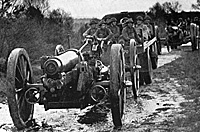 At right: Six-inch howitzers being towed after firing practice. Sixteen of these guns in two batteries formed a Medium Artillery Regiment. Fourteen such regiments were stationed in France with the BEF at the time of the German invasion.
At right: Six-inch howitzers being towed after firing practice. Sixteen of these guns in two batteries formed a Medium Artillery Regiment. Fourteen such regiments were stationed in France with the BEF at the time of the German invasion.
For a number of reasons, which include political mistakes made by Hore-Belisha, and political ruthlessness on the part of Winston Churchill, Hore-Belisha never carried out the reforms or reorganizations recommended by Britain's greatest strategist. It is a very debatable point as to whether such reforms were possible. Certainly the Army heads were violently opposed to both Liddell Hart's suggested reforms and Hore-Belisha himself. The War Minister tried delaying tactics, attempted to play games with the Army men, and in general compromised when, perhaps, he should have used his instructions from Chamberlain widely and literally.
The result was a series of compromises unsatisfactory to anyone, and finally Hore-Belisha's transfer to another political post. He had accomplished several important reforms, and it can be argued that what successes the BEF had were largely due to his efforts; but, like the BEF, Hore-Belisha failed. He did not create a modern British Army, and the German Panzer divisions swept through France in one of the most startling victories in military history.
Let us assume that the French learned nothing and forgot nothing, and went into battle in 1940 with their historical order of battle and forces; but assume also that Hore-Belisha, guided by Liddell Hart, made "drastic changes" in the British Army and sent to France a BEF that although smaller than the Wehrmacht, knew at least as much about armored war as the Germans. The 1940 campaign would then have been very different.
Liddell Hart's Concept of the British Army
Liddell Hart's reorganization plan for the Army consisted of a number of "packages," each one separately capable of implementation. Thus we have the possibility of not one, but several new orders of battle. They will range from a minimum (chosen because if less had been done it would probably have had little effect on the Battle of Fiance) to the "Ideal" force which required an increase in Army appropriations and numbers.
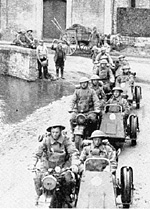 At right: Motorcyclists of the 4th Royal Northumberland Fusiliers, one of three such battalions employed by the BEF.
At right: Motorcyclists of the 4th Royal Northumberland Fusiliers, one of three such battalions employed by the BEF.
The "Ideal" force would have been politically unlikely even if Hore-Belisha had acted with all possible vigor. Increasing the size of the Army was unpopular in Britain -- the U.S. antipathy to standing armies is legitimately inherited from our English forebears, and in fact is less vehement than the British hatred of large Royal Armies in peacetime. However, there were political trends in Britain which if exploited might have made the "Ideal" force possible; and reforms in the financial system might have paid for it from funds actually voted.
The basic concept of Liddell Hart's reorganized Army was mobile armored forces. He pointed out that this type of force would have a far greater effect in France than infantry divisions, because the French had plenty of infantry but few mobile armor divisions.
To Liddell Hart, a mobile armor force was one that could fight mounted. Reconaissance was a secondary mission, and any non-mobile "W1" to an armored force was worse than useless.
Secondly, he believed that the remaining infantry had to be motorized and learn to fight as mobile units. The BEF was in fact motorized, but the doctrines of mobile war were taught too late, if at all.
Thirdly, Liddell Hart advocated drastic reorganization of the Territorial Army. The Territorials, a Reserve/National Guard force, were officered by local squires with a leavening of professional soldiers. Promotion into the Territorials was generally a dead-end for a career man; and even the full time Territorial cadres were paid less than the equivalent rank in the regulars. There was never any question of the Territorials becoming a great deal more effective than they were.
Fourthly, Liddell Hart believed in Anti-Aircraft defenses. He was dead wrong in one respect: he thought that fixed emplacement AA guns were a superior type of defense for Britain itself. On the other hand, even the Army chiefs who opposed Liddell Hart thought that AA/Anti-Tank guns mobile enough to keep up with motorized divisions were valuable, and in fact there was a paper AA/AT regiment committed to the BEF. Unfortunately it went badly trained and without most of its guns; but it is very reasonable to assume that part of the vigorous reorganization of the army would have been the creation of these AA/AT mobile units -- and recall the effectiveness of such units in North Africa under Rommel.
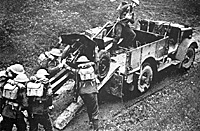 At right: British troops unload a 2-pounder (40mm) anti-tank gun from it, transport lorry. These guns were capable of penetrating the armor on any German tank, at ranges up to 1,500 yards.
At right: British troops unload a 2-pounder (40mm) anti-tank gun from it, transport lorry. These guns were capable of penetrating the armor on any German tank, at ranges up to 1,500 yards.
Finally, Liddell Hart advocated promotion of men who had experience with tanks and mobile war. His promotion recommendations and his reorganization of Sandhust would alone have had the effect of preparing the BEF to fight in what Liddell Hart called tank-time. If the BEF from Commander-in-Chief down through subalterns had understood the tempo of modern war, the results might have been greatly different.
The Reorganization Plan: The "Packages"
1. Reform of the Territorials. Promotion to a Territorial post would have greatly increased Territorial effectiveness and the availability of more troops: both units and replacements.
2. More Anti-Aircraft guns including mobile AA forces. The Army chiefs themselves would have insisted on the mobility.
3. Creation of mobile armored divisions as follows:
- 3.1 Armored Division in Western Desert of Egypt;
3.2 Armored Mvision on frontier of Italian East Africa;
3.3 Armored Division in India;
3.4 Reorganize the Home Field Force from five infantry divisions and one armored mobile division to two infantry divisions and a minimum of three armored mobile divisions;
3.5 Creation of two Territorial armored mobile divisions;
3.6 A complete change in the composition of armored divisions;
3.7 Motorization of all infantry, and training of infantry in modern war;
3.8 A total re-organization of the Imperial General Staff.
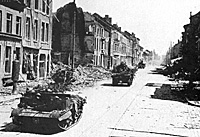 At right: Bren carriers and light Mk VI tanks pass through a shell-damaged Belgian town in the move to the Dyle line. This unit is part of a cavalry regiment, one of four such units brigaded for reconnaissance purposes in the BEF.
At right: Bren carriers and light Mk VI tanks pass through a shell-damaged Belgian town in the move to the Dyle line. This unit is part of a cavalry regiment, one of four such units brigaded for reconnaissance purposes in the BEF.
In the event, the motorization took place, but not the training; and the changed character of the Army happened only on paper. The BEF never sent the entire First Armored Division -- the only one Britain had at home -- into France. They did send the Army Tank Brigade of "I" tanks for infantry support, and the Brigade performed well; but it was not armored division.
Under Liddell Hart's plan, a British armored division would consist not of two cavalry brigades with light tanks and one tank brigade, as it did, but rather of "a reconaissance group of two cavalry regiments (in light tanks), and a striking group of two tank brigades entirely composed of cruiser and medium tanks. Although the total number of armored fighting vehicles would be less than in the existing General Staff pattern of Mobile Division -- 390 instead of 620 -- more than two-thirds of them would be of a fighting type."
 At right: An anti-tank position in bomb-shattered Louvain, one of the Belgian cities on the Dyle River line.
At right: An anti-tank position in bomb-shattered Louvain, one of the Belgian cities on the Dyle River line.
Probable Effect of the Changed Character of the BEF
With the new all-mobile BEF, the Allied Command would have had a compact striking force that could be concentrated against German Panzer penetrations. Armored battles would have resulted, and certainly the Germans would have been unable to over-run France with ease. They might eventually have conquered France, but hardly quickly or dramatically.
What this changed tempo would have done to world history is difficult to estimate, but the effect would have been tremendous. Italy would probably have remained neutral. The Soviet Union would have re-evaluated the worth of the alliance with Germany. American pressure on Germany would have been very strong.
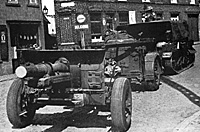 At right: Most BEF artillery was tractor-drawn like this 18-pounder moving across the Belgian border.
At right: Most BEF artillery was tractor-drawn like this 18-pounder moving across the Belgian border.
Without a dramatic and exhiliarating German victory, the Wehrmacht commanders, doubts about wars of conquest would have resumed. After the Fall of France, anything seemed possible to German arms; but a protracted and indecisive battle of France, particularly a costly war of attrition, would have made the Generals wonder if it was worth it. There was, after all, political resistance to Hitler within Germany. His revolution was costly to the upper classes, and only dramatic victories could blind the mass of Germans to the dangers of National Socialism. For that matter, Hitler's own political acumen, which had been considerable, might have resumed; he might have suggested a negotiated peace.
All this is speculation. We cannot know what the political effect of a strong BEF would have been for Europe, and for that matter, the British Empire, and the whole world.
We can be sure that if Liddell Hart and Hore-Belisha had been successful they would have changed the history of the world.
Back to Conflict Number 5 Table of Contents
Back to Conflict List of Issues
Back to MagWeb Master Magazine List
© Copyright 1998 by Dana Lombardy
This article appears in MagWeb (Magazine Web) on the Internet World Wide Web.
Other military history articles and gaming articles are available at http://www.magweb.com